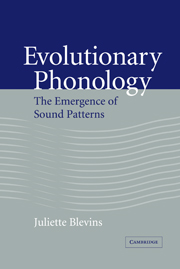1 - What is Evolutionary Phonology?
Published online by Cambridge University Press: 22 September 2009
Summary
In language, as in nature in general, everything moves, everything is alive and changing.
Baudouin de Courtenay (1897/1972)Relating sound patterns to sound change
The field of modern linguistics is conventionally divided into distinct subfields, defined by the questions they address and analytical methods they use to answer these questions. Establishing a clear separation between the components of a synchronic description has proved particularly useful in investigating the distinctive properties of sound systems (phonology), words (morphology), and phrases (syntax). Yet the strict segregation of synchronic and historical description has a rather different character, as it is very often the case that these subfields overlap in their coverage. The post-Saussurean tradition has tended to dismiss historical explanations as entirely irrelevant to the task of synchronic description, on the grounds that the speaker of a language cannot be expected to know the history of that language and “a segment does not know where it came from” (Lass 1984: 178). This essentially ahistorical perspective leads to considerable redundancy, as numerous commentators have observed, since many patterns with a well-understood historical basis or origin must be reencoded in synchronic accounts. The fact that such patterns typically lack system-internal motivation within the synchronic grammar has likewise expanded the inventory of “universals” that must be attributed to a linguistic system because they cannot in any way be deduced or inferred from other properties.
- Type
- Chapter
- Information
- Evolutionary PhonologyThe Emergence of Sound Patterns, pp. 3 - 24Publisher: Cambridge University PressPrint publication year: 2004



